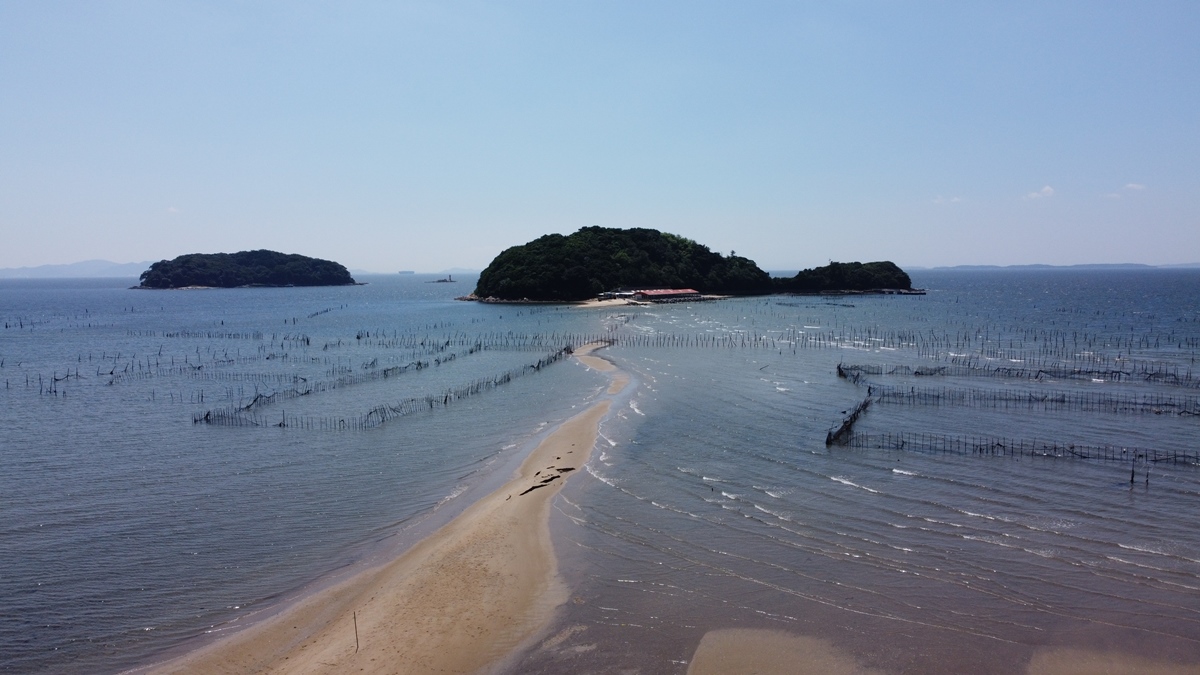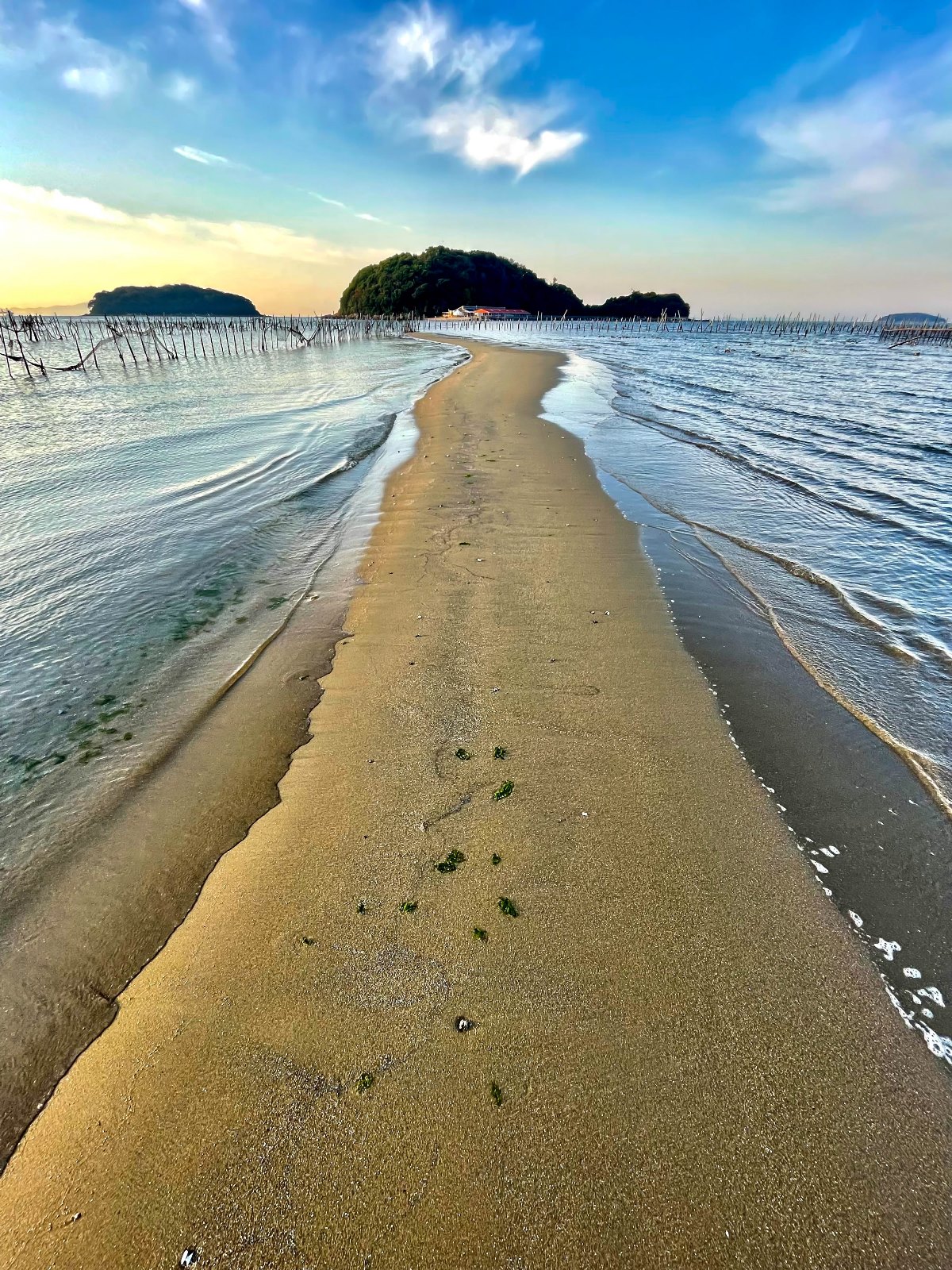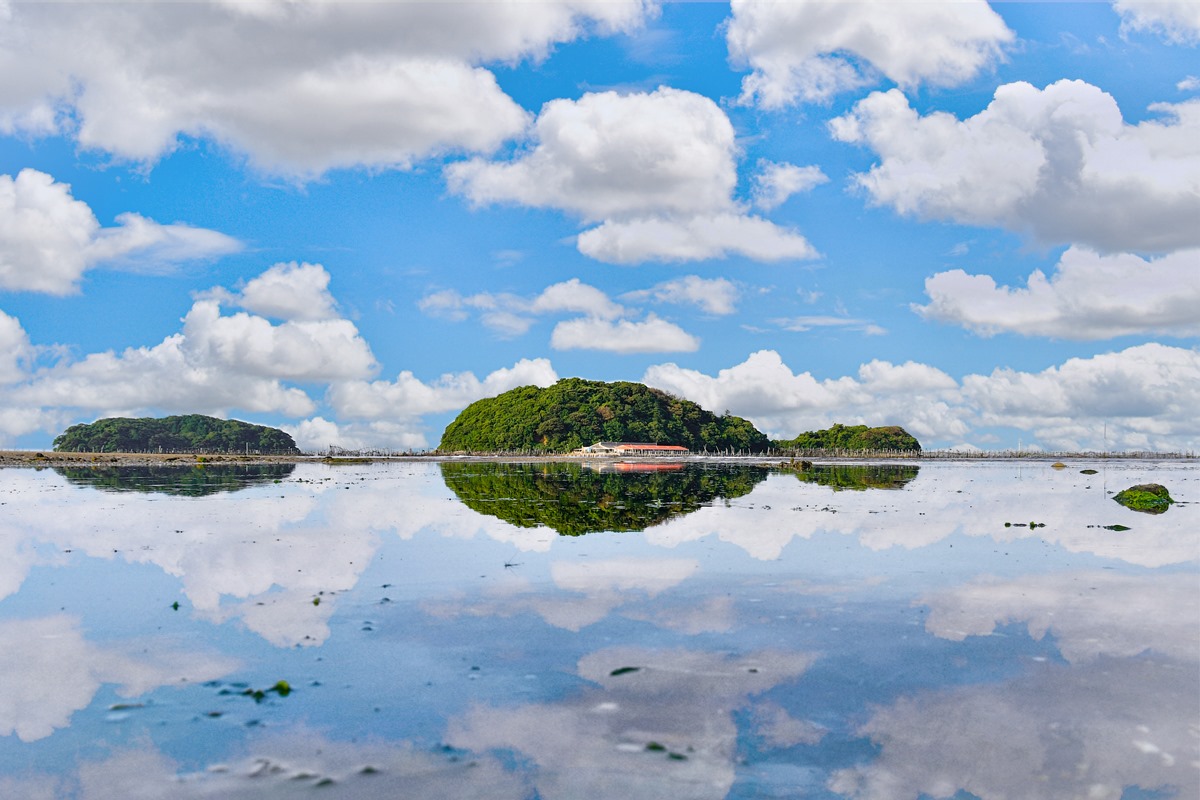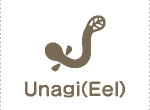Tombolo beach

Higashi Hazu, a city located on Mikawa Bay, is home to the Tombolo Tidal Flat, where the rare tombolo phenomenon can be seen. At low tide, visitors can walk across to Maejima, an uninhabited island at the tip of the tombolo, and enjoy a barbecue if they make a reservation. The flats appear as the tide recedes, so depending on timing you may not be able to see it, but you can still experience nature’s mystery.
Currently, visitors can walk across to Maejima Island only during the “Shiohigari” (clam digging) season, and there is a fee of 300 yen per person. However, visitors can enter the island by contacting the local management association in advance.
Additionally, the island is fenced off except during the clam digging season.
Since its appearance depends on the tide, you may not be able to see it at certain times, but you’ll be able to enjoy the mystery of nature.
Experience the tranquil scenery of Mikawa Bay, views of Maejima Island that change with the seasons, and the tombolo,with its mudflats and the rich variety of creatures that live there!
Tombolo in Hazu
Normally, this island is viewed from across the sea. At low tide, a path emerges from the sea, letting you walk across to the far shore. …… Did you know that this mysterious tombolo phenomenon, famous at Mont Saint-Michel, can also be seen in Japan?

Tombolo and Maejima Island seen from the Higashi Hazu coast side
Higashi Hazu Town, Nishio City, Aichi Prefecture. Off the coast of Higashi Hazu, also famous as a clam digging spot, there’s an uninhabited island called “Maejima.” The distance from the beach to Maejima is 470m each way, and although normally the island is separated by the sea, it is possible to walk across the mudflats to Maejima for a few hours at low tide.
Currently, visitors can walk across to Maejima Island only during the “Shiohigari” (clam digging) season, with a 300 yen per person fee required. However, visitors can enter the island by contacting the local management association in advance.
“The tide lowers and the path to Maejima Island begins to emerge.”
The tombolo is a mysterious path that appears for only a few hours a day. It was once said among the locals that seeing the tombolo would bring good luck, and that if one walked across it, his or her wish would come true.
“When the tide drops to its lowest point, a rippling topography appears.”
When the tide recedes and the flats are uncovered, you can see the unique rippled pattern of the sand. Sea creatures are alarmed by the sudden disappearance of seawater. Observing creatures like crabs and shellfish that live on the tidal flats as they hurry to find seawater is one of the pleasures of walking the tombolo as well.
“The creatures of the tidal flats are very busy.”
On Maejima Island, at the far side of the tombolo, there’s a bell called “Hazu no kane.” If you ring the bell, your wish may come true.
You can walk to and from Maejima and the Higashi Hazu Coast for only a few hours at low tide. If you make the trip, please be careful not to find your path back blocked by rising waters.
“When the path is about halfway underwater. The sound of waves crashing from both sides of the path is soothing”
On the day of our visit, low tide was around 12:30 pm. The tombolo is best seen when the road linking the two shores is quite narrow. If 12:30 pm is the low tide, the best time for viewing the tombolo is around 10:30 am or 2:00 pm. Since this is a natural phenomenon that appears depending on the tide, please check the tide schedule and arrange your visit accordingly.
“At dusk, the tide was rising and the flats were almost completely sunken.”
Please note that in order to protect the fishing grounds, there is a fee to enter the tombolo area (300 yen per person, for elementary school students and older). Viewing the tombolo from outside the restricted area is free of charge, but in order to cross the tombolo, visitors must enter the paid area.
“A spectacular view of the sunset from Higashi Hazu Beach”
It was around 5:00 pm in the evening of the day of the interview. Although the tide was high and the tombolo had vanished, the Higashi Hazu Coast offered a spectacular view of the setting sun across the calm waters of Mikawa Bay. From mid-March to mid-August every year, you can also dig for clams at low tide, so in addition to walking the tombolo, you’ll find many ways to enjoy the area.
use the tide pools of the tombolo for reflection photography

It takes between 4 and 5 minutes to walk from Higashi Hazu Beach to Maejima Island. The path is about 470 meters long. After the tide dropped, a few people were crossing from the beach to Maejima. Maejima was once a popular “rabbit island,” but is now uninhabited.
When the tide falls, an unusual rippling pattern appears. If you look carefully, you can see sea creatures peeking out. The small crabs seem surprised by the lack of saltwater. They move out in search of water.
Some people use the tide pools of the tombolo for reflection photography. Reflection photography is a technique that takes advantage of reflections in the water or mirrors. It’s possible to take beautiful photos and videos in which the earth and sky appear to be connected.
Four hours after low tide, the tide gradually rises. The sea returns to normal. Maejima Island, which seemed so close earlier, feels farther away.
The time and shape of the tombolo vary by season. You can spend a relaxing time on the mysterious tidal flats along with the tranquil scenery of Mikawa Bay.
Higashi Hazu Town, Higashi Hazu Coast Access Guide
By Train
From Meitetsu Nagoya Station, transfer at Shin-Anjo Station to Nishio Line or Gamagori Line and get off at Higashi Hazu Station. (about 1 hour and 30 minutes)
From Toyohashi Station, take the JR Tokaido Main Line to Gamagori Station. Change to the Nagoya Railroad (Meitetsu) Gamagori Line and get off at Higashi Hazu Station (about 45 minutes).
By Car
From Tomei Expressway “Otowa Gamagori IC,” take Take Orange Road (Otowa Gamagori Road), Route 23, and Route 247 to Higashi Hazu.(About 40 minutes from Otowa Gamagori IC).
From the Okazaki IC of the Tomei Expressway, take Route 248 to Gamagori, and then take Route 247 to Higashi Hazu Town. (About 50 minutes from Okazaki IC).
From “Otowa Gamagori IC” of Tomei Expressway, approx. 80 min. via Otowa Gamagori Toll Road, Route 23 and Route 247
From Nagoya Expressway “Nagoya-Minami JCT”, approx. 60 min. via Bypass National Route 23
Approx. 60 min. from Handa IC of Chita Hanto Road via Kinuura Tunnel and Route 247.
Contact
| Address | 20-3, Gyoda, Omi, Higashi Hazu-cho, Nishio City, Aichi Prefecture, Japan |
|---|---|
| TEL | 0563-62-2068 |




























